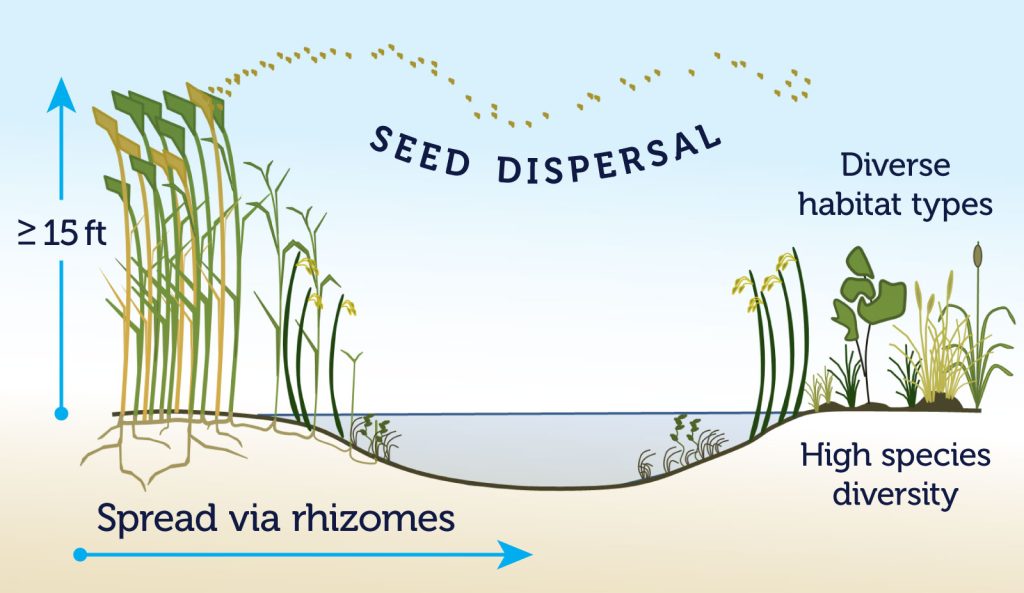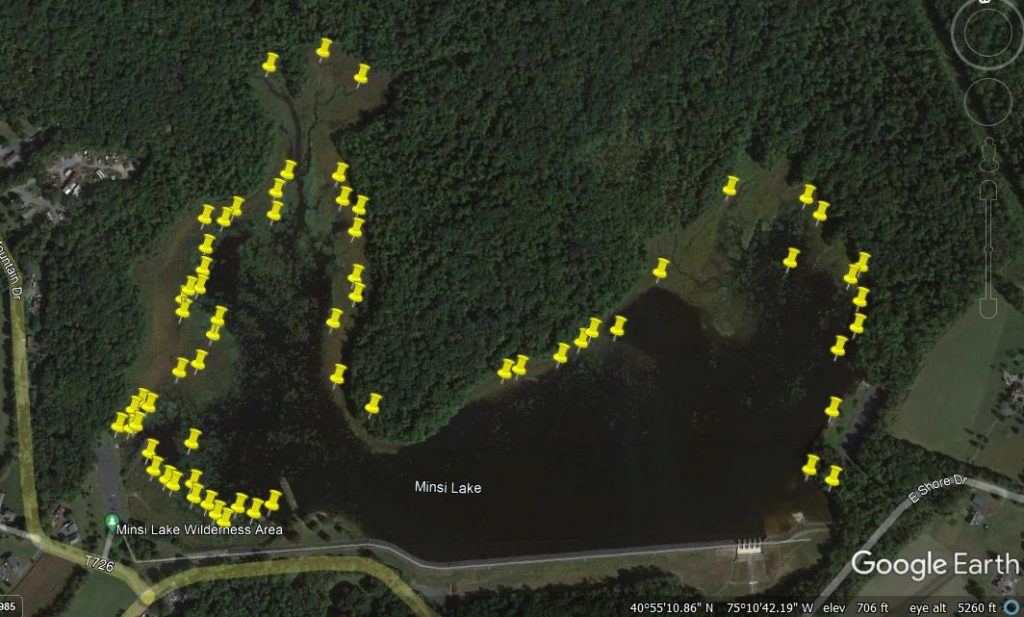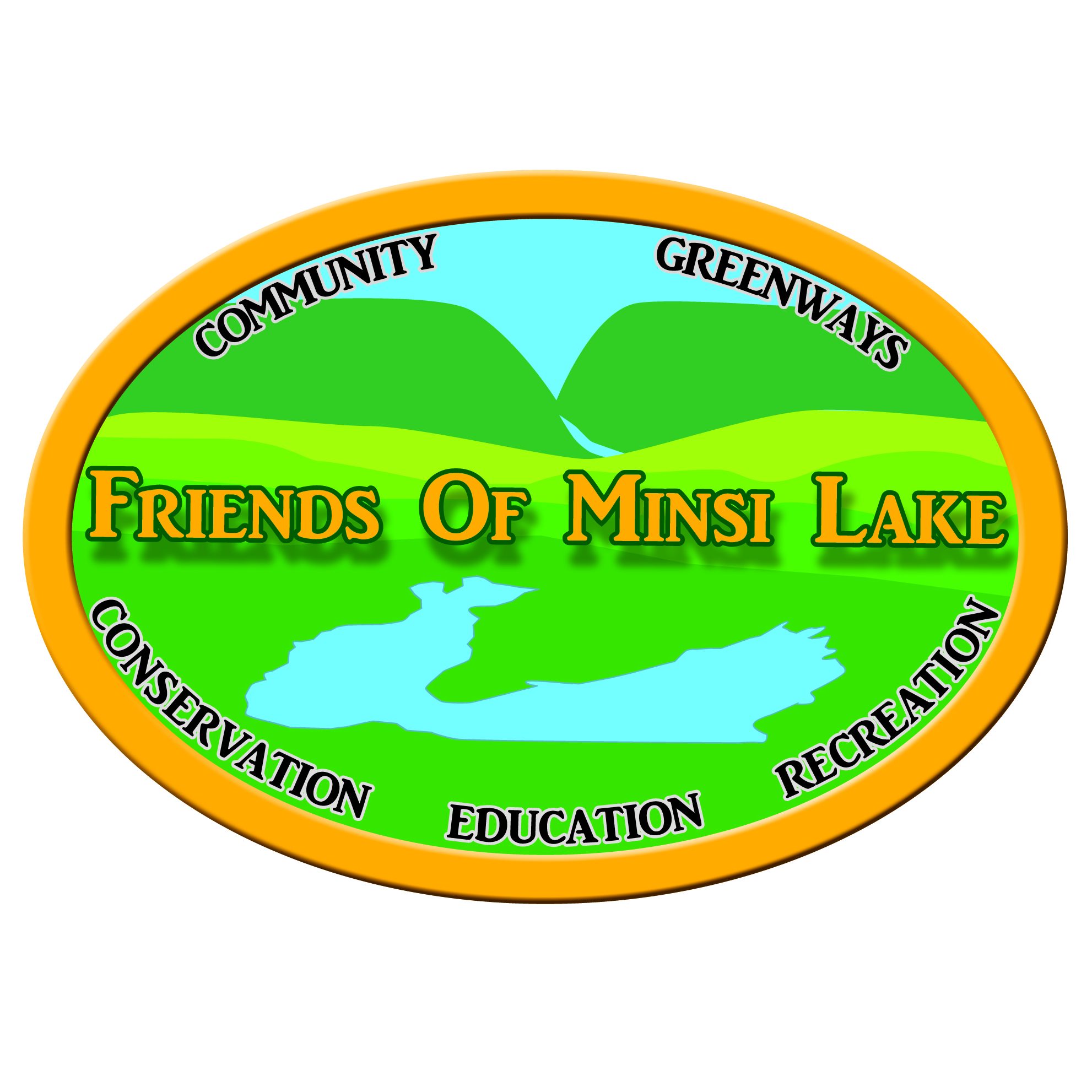
Controlling Aquatic Invasive Plant Species at Minsi Lake
Aquatic Invasive Species are aquatic plants and animals that have been introduced into waterways in which they do not naturally occur. Oftentimes, these invasive species have no natural predators or other controls to keep their populations in check, and they can quickly overtake an area to the detriment of native plants and animals.
In 2021, staff from the PA Fish & Boat Commission (PFBC) and Northampton County Parks (NorCo Parks)
conducted an assessment to evaluate the status of aquatic invasive plants at Minsi Lake. The assessment
identified Phragmites, Purple Loosestrife and Eurasian Water Milfoil as invasive plant species growing in the waters of the lake. Additionally, over an acre of Japanese Knotweed, another invasive aquatic plant species, was documented growing at a number of sites located away from the lake, but within Minsi Lake Park.

Purple Loosestrife grows along most of the shoreline at the lake. Due to its moderate impacts and widespread establishment along the shoreline, it is not practical or feasible to manage loosestrife at Minsi. Similarly, Eurasian Water Milfoil—a submerged aquatic invasive plant species—is well established at the lake and managing it is not practical or feasible, either. NorCo Parks staff have been successfully managing knotweed at Minsi Lake Park for several years now, and will continue to do so into the future.
Target Aquatic Invasive Plant Species at Minsi Lake: Phragmites
Phragmites is a recent colonizer at Minsi Lake, having first established itself in the muddy lakebed following the lake’s drawdown for a dam rehabilitation project in 2017. Since the 2020 refill of the lake, Phragmites presently occurs in relatively low abundances and is still feasible to control. PFBC recommends that Phragmites be the focus of aquatic invasive plant management at the lake. PFBC recommends managing Phragmites as a high priority, as it has a strong likelihood of displacing native vegetation and encroaching on native habitats and recreational resources at Minsi Lake.
Given the tendency for Phragmites to spread rapidly via rhizomes, if unmanaged, PFBC predicts it will likely overtake much of the shoreline at Minsi Lake in 5 to 7 years. Phragmites can form dense stands up to 15’-20’ tall that displace native vegetation and substantially alter habitats for native plant and animal species.


Dense stands of Phragmites can also significantly exclude shoreline access for anglers and block access to fishing and boating, diminishing the recreational value of Minsi Lake. Furthermore, tall stands of Phragmites will block aesthetic views into the adjacent woodlands from the lake. Finally, a population of a State-Threatened reptile species occurs in low abundance at Minsi. Basking habitat is critical for this species of conservation concern, particularly basking habitat in the shallow waters at the lake. This critical habitat is at high risk of being shaded out of use by dense stands of Phragmites, thus jeopardizing this threatened species.

Our Phragmites Control Plan for Minsi Lake
Following the 2021 assessment of aquatic invasive plant species at Minsi, PFBC produced an Aquatic Invasive Species Control Plan for Minsi Lake. In support of that plan, NorCo Parks received funding from the PA Lake Management Society to begin to control Phragmites at the lake.

The 2021 assessment identified a total of about two acres of Phragmites located at dozens of GPS-mapped points on the lake, mostly along the shallow shoreline, but also in deeper water away from the shoreline. PFBC recommends that both shoreline and deeper water stands of Phragmites be treated with a broad-spectrum, glyphosate-based, foliar spray herbicide that is approved for use by the Commonwealth of PA and applied by a licensed professional pesticide applicator. The herbicide must be a formulation approved for aquatic use in order to mitigate impacts to aquatic organisms, such as fish and amphibians. PFBC does not expect Phragmites control activities to affect the State-Threatened reptile species that is found at the lake, and in fact should improve and preserve its critical basking habitat.

Per the PA Lake Management Society Grant Agreement with NorCo Parks, Phragmites must be treated at
Minsi Lake by August 18, 2023. The Parks Department has contracted with a lake management company to apply the herbicide treatment by the deadline. Subsequent treatments will be required in successive years to bring Phragmites under control at the lake and sustain its long-term management. Public notices will be posted prior to any herbicide application at the lake.

Friends of Minsi Lake (FOML) has stepped up to collaborate with NorCo Parks to provide public outreach,
communications and messaging about the need for treating Phragmites at the lake, and our cooperative
partnership with PFBC and other conservation partners to do so in the most responsible way. Please see the many links and resources under AIS Outreach below for more information about Phragmites, its ecological threats and how to manage it.

Post Treatment Monitoring at Minsi Lake
PFBC also recommends NorCo Parks and FOML implement a monitoring protocol to evaluate the short and long term successes of herbicide treatments of Phragmites at the lake. It is effectively impossible to
completely eradicate Phragmites. Some plants will survive or regenerate post-treatment and will require
follow-up treatments from time to time to keep them under control. It is likely Phragmites will continue to be reintroduced to Minsi Lake by seed dispersal from other local sites.

Monitoring is relatively simple and can consist of annual or bi-annual surveys of Aquatic Invasive Species,
revisiting treated areas to evaluate control success, identifying new or persistent growth for spot treatment and surveying for other Aquatic Invasive Species as a means of early detection. One or two people with the FOML Partnership could easily achieve these monitoring objectives in one day. PFBC recommends that NorCo Parks and FOML follow the technical guidance for Aquatic Invasive Species monitoring established by the Consortium for Scientific Assistance to Watersheds

Minsi Lake Phragmites Control Plan Timeline
2023:
– Conduct treatments for both shoreline and open water stands of Phragmites by August 18.
– Post public notices with the date of treatment and any water use or access restrictions on the bulletin
boards at Minsi Lake Park, at both boat launches and at both fishing docks as soon as treatment is
scheduled. Post this same notice on NorCo Parks and FOML social media ASAP.
2024:
– Conduct 2 nd Year treatment of Phragmites as needed between August-October.
– Follow C-SAW’s protocols for monitoring Phragmites and other Aquatic Invasive Species.
2025 & Beyond:
– NorCo Parks staff and conservation partners will continue to implement the partnership’s Aquatic
Invasive Species Monitoring & Suppression Program on an annual basis.
Stop the Spread of AIS
In addition to Phragmites, Purple Loosestrife, Eurasian Water Milfoil and Japanese Knotweed mentioned
above, Pennsylvania has nearly 200 other documented Aquatic Invasive Species (AIS) and of these,
approximately 50 species are considered potential major threats to the Commonwealth’s natural freshwater resources. According to PFBC, some of the “least wanted” AIS in Pennsylvania are New Zealand Mudsnail, Zebra Mussel, Northern Snakehead, Sea Lamprey, Hydrilla, Spiny Water Flea, Asian Clam and Red-eared Slider.

PFBC also tells us that anglers and boaters can be the first line of defense against introducing AIS into new waters. Follow simple steps—check, drain, clean and dry gear—to prevent the spread of AIS (this should be a hyperlink to PFBC’s 47 sec. video Help Prevent the Spread of AIS here:
When done boating for the day, check your boat, motor and trailer for weeds and other things “tagging
along.” No hitchhikers!
– Drain livewells, bilges and other compartments in your boat.
– Drain all standing water from your boat.
– Don’t dump leftover bait into the water you’re fishing, unless you collected the bait there.
Clean Your Gear to Stop Aquatic Hitchhikers


Report AIS
Pennsylvania Fish and Boat Commission
Aquatic Invasive Species Reporting Form

AIS Outreach
PFBC Videos:
Getting to Know New Zealand Mudsnails
Getting to Know Red-eared Sliders
Getting to Know Rusty Crayfish
Getting to Know Curly Pondweed
Getting to Know Hydrilla
Governor’s Invasive Species Council

Wildlife Forever/Invasive Species



